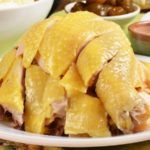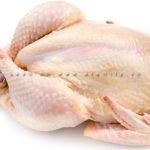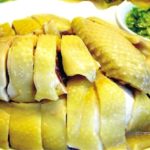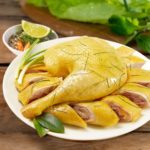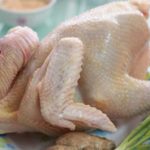The boiled chicken is an indispensable dish in festive occasions and ancestral worship. Many believe that preparing the chicken for worship as desired will help them welcome a good new year. The selection, boiling, and placement of the chicken for worship is always done much more carefully than boiling chicken for regular consumption, to show the respect of the homeowner for the ancestors and the deities.
Because of the caution, many people are interested in meticulous details such as when to place the roast chicken, when to place the boiled chicken, where to place the chicken for worship, what is different for the ancestral altar, the God of Wealth, the Earth deity…?
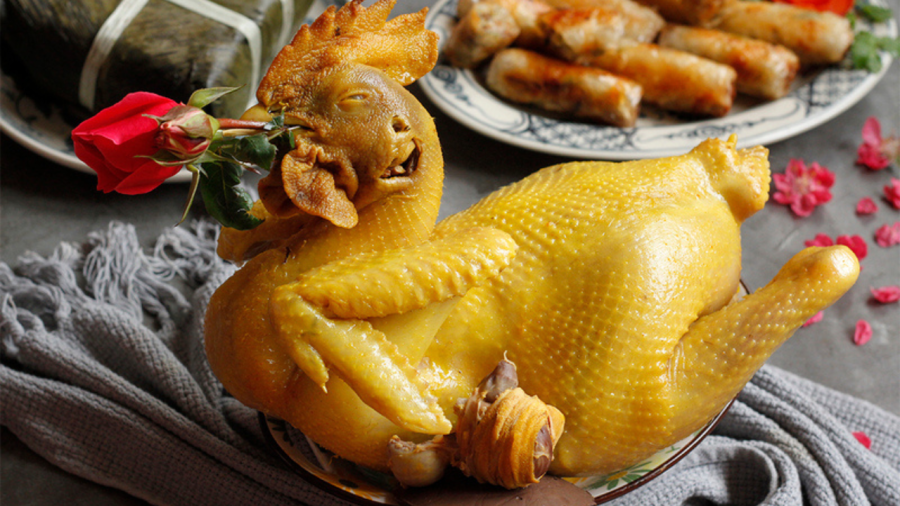
The chicken is a familiar offering for the altar
Why choose a rooster for worship?
According to Dr. Tran Thi Thu Thuy (Head of Education Department, National Museum of Ethnology of Vietnam), the male chicken is considered an important animal in folklore, signaling good things, bad things, and predicting the future… At the beginning of the year, some ethnic groups like the Hmong, Tay… often place a rooster for worship in front of the altar, perform ritual cutting, and release it to see which direction the rooster’s head will turn to predict the success or failure of their business in that year.
If the rooster’s head turns towards the ancestral altar or the owner’s room when it dies, the family will prosper in business that year. If the rooster’s head turns towards the door, it will be difficult in business and will waste money. They will sacrifice another rooster, and if it’s the same, they will invite a priest to perform a ritual… As for the Vietnamese people, choosing a chicken for worship is simpler.
However, the chicken for worship on New Year’s Eve must be a lively rooster, with a vibrant crow, without any defects, with red or reddish-yellow feathers, a straight, single comb, a yellow beak, yellow legs… and most importantly, it has not mounted a hen (signifying health, purity) for the prayers to be effective.
For the Vietnamese, the rooster serves as a bridge between the human world and the spiritual world, a chosen animal to offer to the deities and ancestors on every Tet holiday. The chicken is a symbol of culture associated with the sun worship of agriculture, gradually becoming a custom of every Vietnamese family when Tet comes, spring arrives.
People worship the rooster with the hope that it will awaken the sun, bringing full sunshine throughout the year, and bringing favorable weather conditions to agriculture.
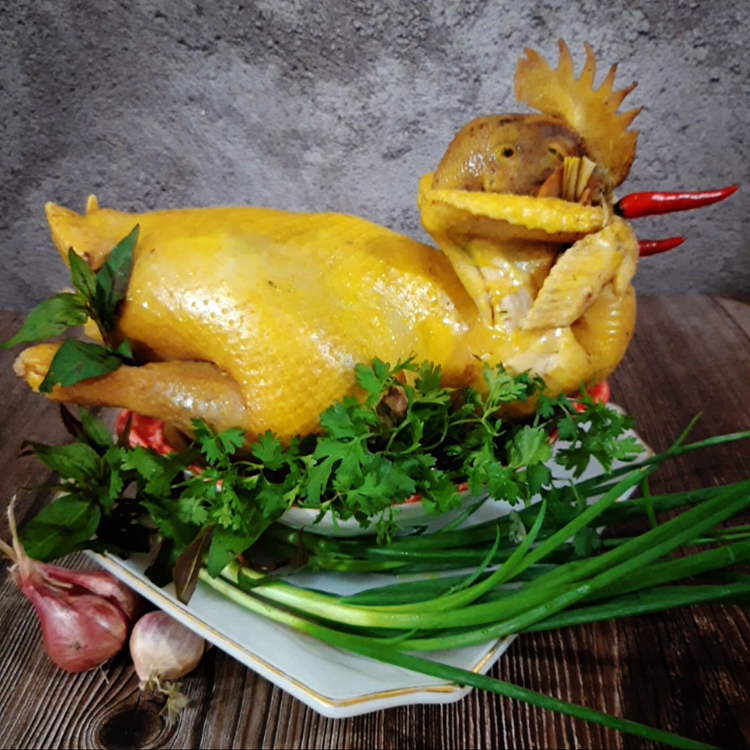
The chicken holds many meanings in ancestral worship
How to place the chicken on the altar?
According to Mr. Ha Thanh (Center for Oriental Archaeological Research – Vietnam Union of Scientific and Technical Associations), people believe that having a desired chicken for worship will make them feel reassured to welcome a good new year. “For the New Year’s Eve offering, you should place the rooster with its head facing the street to welcome the New Year’s God’s arrival (according to folk belief, every year the Celestial Court changes all the officials responsible for managing the lower realm. Worshiping on New Year’s Eve is to send off the officials of the old year and welcome the officials of the new year). As for the offering chicken on the ancestral altar, the general belief is to place the chicken with its head facing into the incense bowl, with the posture of open beak, kneeling legs, and natural wings.
This posture is considered as “a crowing and caring chicken”. Do not place the rooster with its head facing outward because it is considered “a chicken that does not care”. Placing the chicken if its head is turned outwards will be more aesthetically pleasing. Placing its head inside will look like a poop sticking out, which is not aesthetically pleasing. However, that is only about the beautiful appearance, it does not have any particular meaning,” said Mr. Ha Thanh.
Also according to Mr. Ha Thanh, when offering the worship, the whole chicken should be left intact to be both beautiful and solemn. For a hen, you can cut it into pieces, but when placing it on a plate, it will not look visually pleasing and reduce the solemnity. If you cut it into pieces, the chicken needs to cool down before cutting so that the meat pieces are neat.
You should not cut when the chicken is still hot because it will be stained by the surrounding dirt, and the chicken meat will be crushed, deformed. Do not use roasted, fried, stewed, or braised chicken because both the appearance and the color are not beautiful, they are unbalanced and not solemn.
Placing the chicken for the God of Wealth, the Earth deity
Similar to how the chicken is placed on the ancestral altar, the chicken for the God of Earth, the God of Wealth should also be placed whole on a plate (the organs should be placed under the abdomen of the chicken). The chicken’s beak is holding a red rose, with its head turned towards the main door.
Tips for boiling the perfect chicken for worship
To have a perfect chicken for worship, you need to pay attention to the selection of the chicken from the beginning. You should choose a rooster, the native chicken weighing about 1.5kg after being slaughtered. Do not buy a too big chicken because it will be harder to make it look beautiful on the offering tray, and the meat will be tougher.
The offering chicken must be healthy, look agile, with sleek feathers, vibrant red comb, yellow skin, small feet, and plumpy breast. A chicken with these features not only has firm meat but also has a more beautiful appearance after being cooked and placed on the tray.
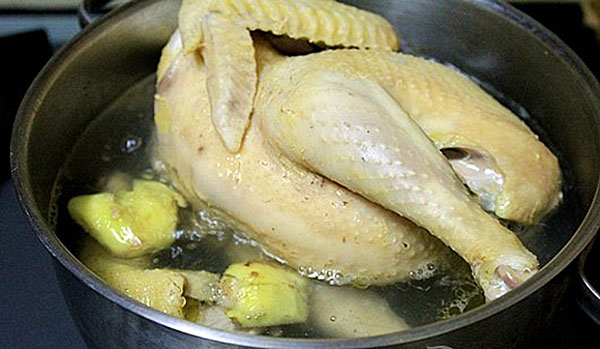
Tips for boiling the perfect chicken for worship
When you bring the chicken home, do not immediately butcher it, you should untie the leg strings, release it into the cage or coop so that it can move around for half a day or at least a few hours to allow blood circulation and prevent the chicken from turning black in the leg part due to blood congestion caused by tying it up.
For the offering chicken, you cannot slaughter it as you would for making fried or roasted dishes or boiling for normal consumption. It must be gutted to create a beautiful shape and avoid skin shrinkage. Cut the legs apart from the thigh to avoid the skin from cracking when boiling, resulting in meat cracking.
To create the shape of a sitting chicken, use a sharp knife to make incisions on both sides of the chicken’s neck, then insert the wings through these two lines towards the beak. This step requires carefulness and skillfulness to ensure that the wings are not bent or broken but still facing outwards towards the beak. If you prefer the shape of a flying chicken, gently bend the two wings towards the back, and tie the joint of the two wings together (tight enough to avoid leaving any marks or tearing the skin after boiling).
Rub turmeric powder all over the surface of the chicken to create a beautiful golden color. Place the chicken in a pot, with the belly facing down, fill it with cold water, and boil it over high heat. Add a few slices of ginger, a little dried shallot, spring onion, a little salt, and seasoning powder… with the purpose of eliminating odors and enhancing the sweetness.
When the water boils, reduce the heat to prevent the chicken’s skin from cracking due to strong boiling, simmer for about 7 minutes (skim off any foam if necessary to make the chicken skin look bright and smooth), then turn off the heat, cover the pot for another 15 minutes for the chicken to continue cooking without the skin cracking. Use a toothpick to poke into the chicken’s thigh, if no red water comes out, the chicken is done.
Transfer the chicken to a pot of cold water to cool it down quickly, making the skin crispier. When the chicken has cooled down a bit, brush a little cooking oil mixed with turmeric powder on the outside of the chicken to have a beautiful and shiny yellow color.

























